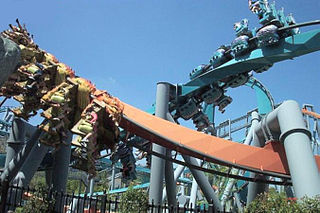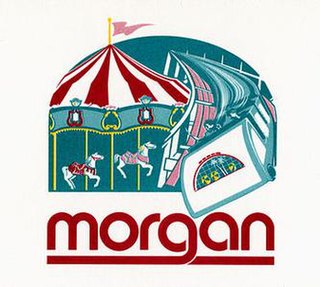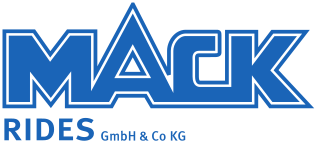
A wooden roller coaster is a type of roller coaster classified by its wooden track, which consists of running rails made of flat steel strips mounted on laminated wood. The support structure is also typically made of wood, but may also be made of steel lattice or truss, which has no bearing on a wooden coaster's classification. The type of wood often selected in the construction of wooden coasters worldwide is southern yellow pine, which grows abundantly in the southern United States, due to its density and adherence to different forms of pressure treatment.

A steel roller coaster is a roller coaster that is defined by having a track made of steel. Steel coasters have earned immense popularity in the past 50 years throughout the world. Incorporating tubular steel track and polyurethane-coated wheels, the steel roller coasters can provide a taller, smoother, and faster ride with more inversions than a traditional wooden roller coaster.

Philadelphia Toboggan Coasters (PTC) is one of the oldest existing roller coaster manufacturing companies in the world. Based in Hatfield, Pennsylvania, it was established in 1904 by Henry Auchey and Chester Albright under the name Philadelphia Toboggan Company. The company manufactured carousels, wooden roller coasters, toboggans and later, roller coaster trains.

The Coney Island Cyclone is a wooden roller coaster at Luna Park in Coney Island, Brooklyn, New York City. Designed by Vernon Keenan, it opened to the public on June 26, 1927. The coaster is on a plot of land at the intersection of Surf Avenue and West 10th Street. The Cyclone reaches a maximum speed of 60 miles per hour (97 km/h) and has a total track length of 2,640 feet (800 m), with a maximum height of 85 feet (26 m).
Harry Guy Traver was an American engineer and early roller coaster designer. As the founder of the Traver Engineering Company, Traver was responsible for the production of gentle amusement rides like the Tumble Bug and Auto Ride. However, Traver's coasters became legendary for their unique twisted layouts and thrilling, swooped turns. At a time when most coasters were built from wood, Traver was the first coaster builder to utilize steel for the primary structural material.

Wicked Cyclone is a steel roller coaster located at Six Flags New England amusement park. The ride originally opened as a wooden roller coaster named Cyclone on June 24, 1983. Its name and design were inspired by the historic 1927 Cyclone roller coaster located at Coney Island. In 2014, after 32 seasons, Cyclone was closed while being re-tracked with steel. It reopened as Wicked Cyclone on May 24, 2015.
John A. Miller was an American roller coaster designer and builder, inventor, and businessman. Miller patented over 100 key roller coaster components, and is widely considered the "father of the modern high-speed roller coaster." During his lifetime, he participated in the design of approximately 150 coasters and was a key business partner and mentor to other well-known roller coaster designers, Harry C. Baker and John C. Allen.

D. H. Morgan Manufacturing, later simply known as Morgan, was a manufacturer of roller coaster trains, custom amusement rides, roller coasters, children's rides and other amusement devices. Founded in 1983, the company was originally headquartered in Scotts Valley, California. In 1991, the company moved to La Selva Beach, California, and into a new 55,000-square-foot indoor manufacturing facility. That facility was later increased to 75,000 square feet. The company produced a variety of rides from 1983 until 2001, but is probably best known for its steel hyper coasters.

Mack Rides GmbH & Co KG, also known simply as Mack Rides, is a German company that designs and constructs amusement rides, based in Waldkirch, Baden-Württemberg. It is one of the world's oldest amusement industry suppliers, and builds many types of rides, including flat rides, dark rides, log flumes, tow boat rides and roller coasters. The family that owns Mack Rides also owns Europa-Park.

The Cyclone was a wooden roller coaster that operated at Revere Beach in Revere, Massachusetts, from 1925 until 1969. When Cyclone was constructed, it was the tallest roller coaster ever built, as well as being the first roller coaster in the world to reach 100 feet (30 m) in height. In addition to being the tallest roller coaster of its day, some also claim that it was the largest and fastest roller coaster in the world, with a length of 3,600 feet (1,100 m) and top speeds between 45 and 50 mph. Cyclone held the title of world's tallest roller coaster until 1964 when it was surpassed by Montaña Rusa at La Feria Chapultepec Mágico in Mexico City, Mexico.

Lightning was a wooden roller coaster that operated from 1927 until 1933 at Revere Beach in Revere, Massachusetts. It was one of the infamous Giant Cyclone Safety Coasters which were constructed by noted roller coaster engineer Harry G. Traver in the mid-1920s. Lightning was the only Giant Cyclone Safety Coaster not to bear the "Cyclone" name, as a roller coaster named Cyclone already existed at Revere Beach when Lightning was constructed in 1927. The other two members of this group of coasters included the Crystal Beach Cyclone and the Palisades Park Cyclone.
Curtis D. Summers was an American engineer and roller coaster designer credited for designing or providing structural engineering on 25 wooden roller coasters around the world. He earned a degree in Architectural Engineering from Kansas State University and was a registered engineer in 40 states.

Rocky Mountain Construction, often abbreviated as RMC, is a manufacturing and construction company based in Hayden, Idaho, United States. The company is best known for its I-Box track and Topper Track for wooden roller coasters.

Jupiter is a wooden roller coaster at Kijima Kogen, an amusement park in Beppu, Ōita Prefecture, Japan.
Alan Schilke is an engineer and roller coaster designer based in Hayden, Idaho, United States. He first made his mark on the industry by designing the 4th Dimension roller coaster, X², while working with Arrow Dynamics. Schilke now works as a design engineer at Ride Centerline LLC and occasionally works with Rocky Mountain Construction (RMC).
Jazz Railway was an early model line of wood roller coasters incorporating a steel-frame structure. These operated at various amusement parks and fairgrounds during the mid to late 1920s. The coaster model is considered to be the first of the Wild Mouse style roller coaster.

The Sesquicentennial Cyclone was a steel-framed wooden roller coaster which was operated at the Philadelphia Sesquicentennial Exposition in 1926. Designed and built by Harry Traver of Traver Engineering, the coaster was a medium-sized prototype of Traver's later Giant Cyclone Safety Coasters.
Zip or Zipp was a steel-framed wooden roller coaster which operated at Oaks Amusement Park in Portland, Oregon. The coaster was a more compact variant of the Giant Cyclone Safety Coasters which were built by Harry Traver of the Traver Engineering Company in the mid to late 1920s.

Thunderbolt was a wooden roller coaster which operated at Savin Rock Amusement Park in West Haven, Connecticut, from 1925 until 1938 when it was destroyed by a hurricane. It was rebuilt in modified form in 1939 and it continued to operate until 1956. When it was first built, it was purported to be the fastest roller coaster in the world.
Giant Cyclone Safety Coasters were a model line of roller coasters designed and marketed by Harry Traver and his company Traver Engineering in the 1920s. Despite their name, they had a reputation of being dangerous and are regarded by many historians as some of the most fearsome roller coasters ever built.














